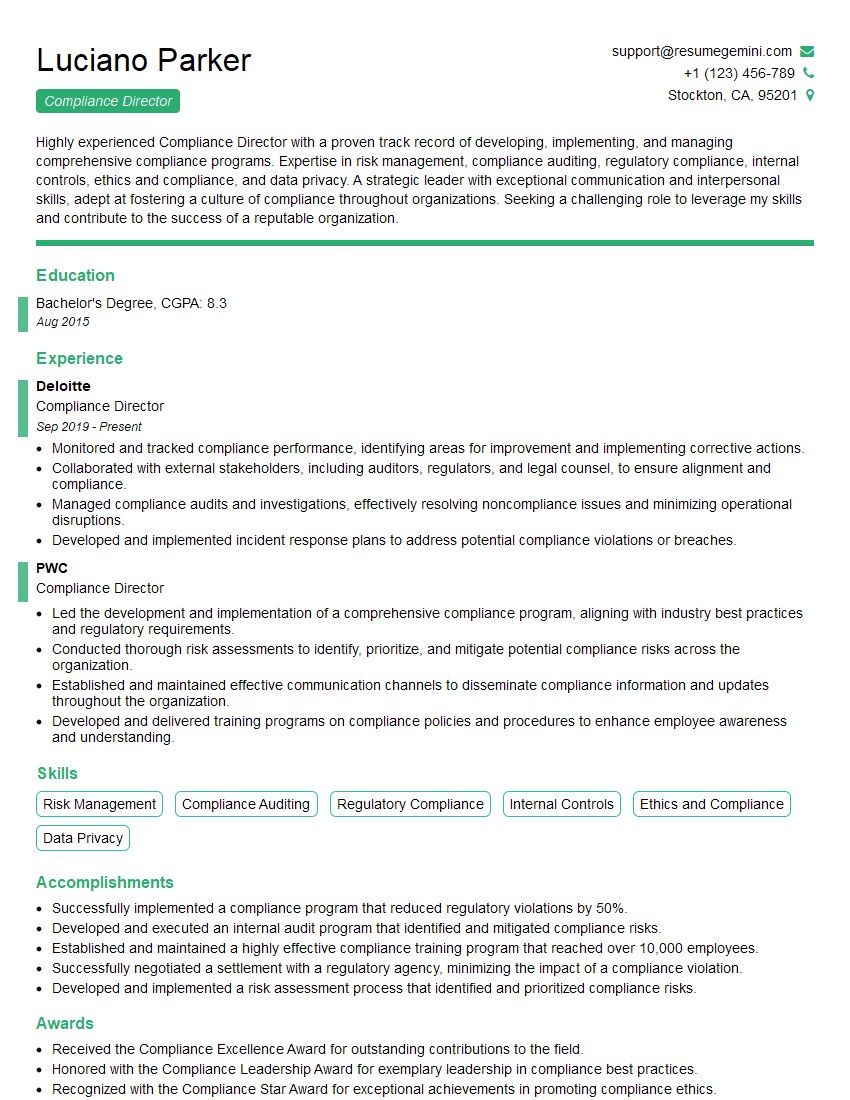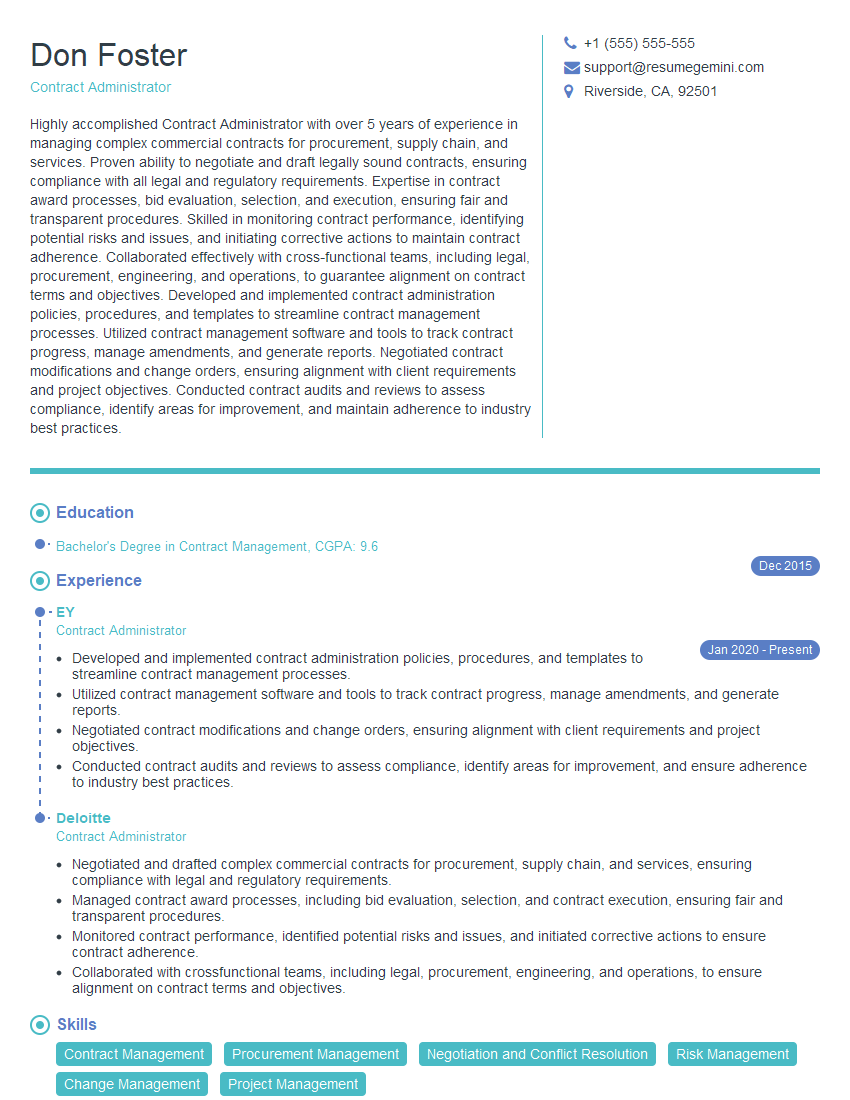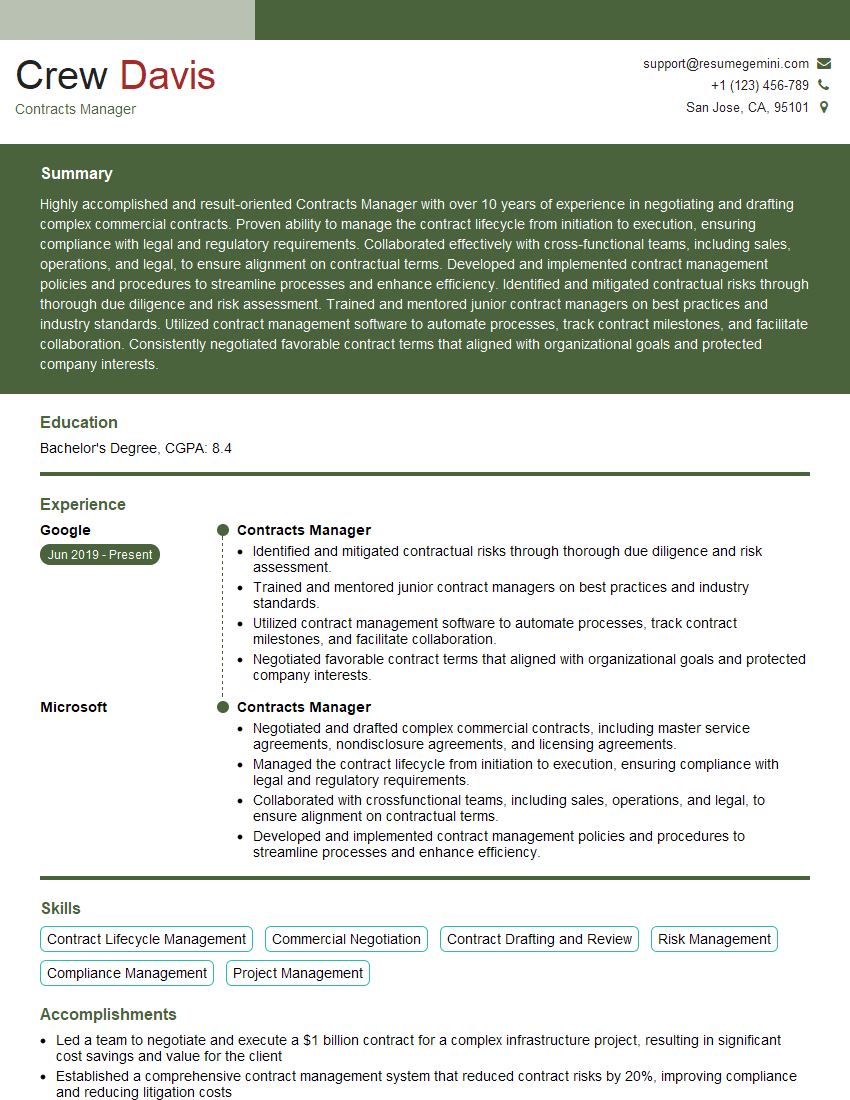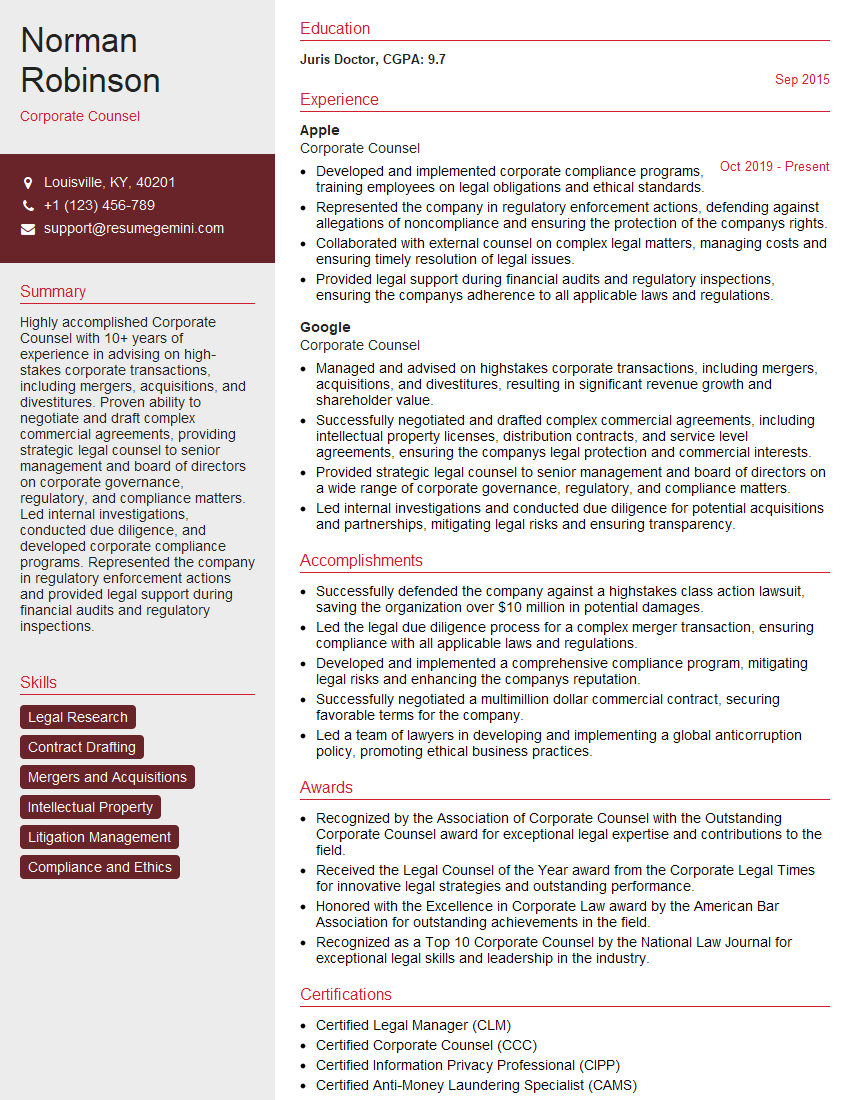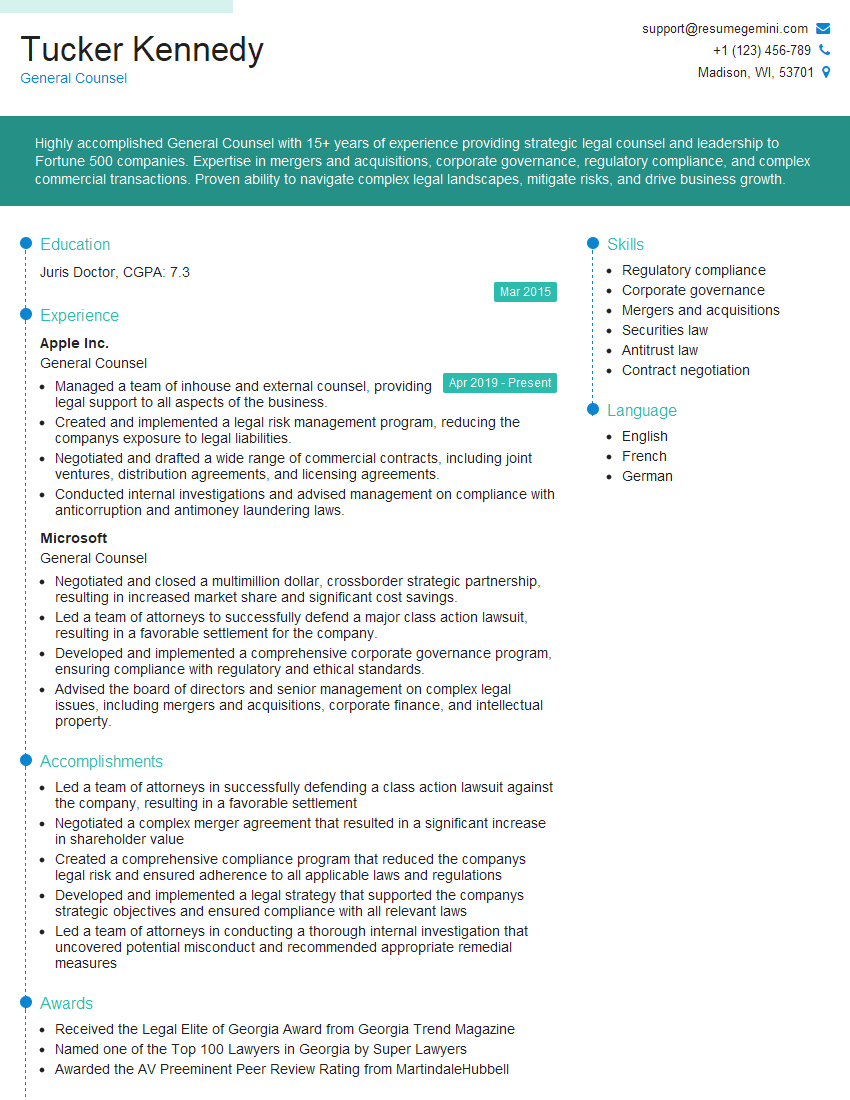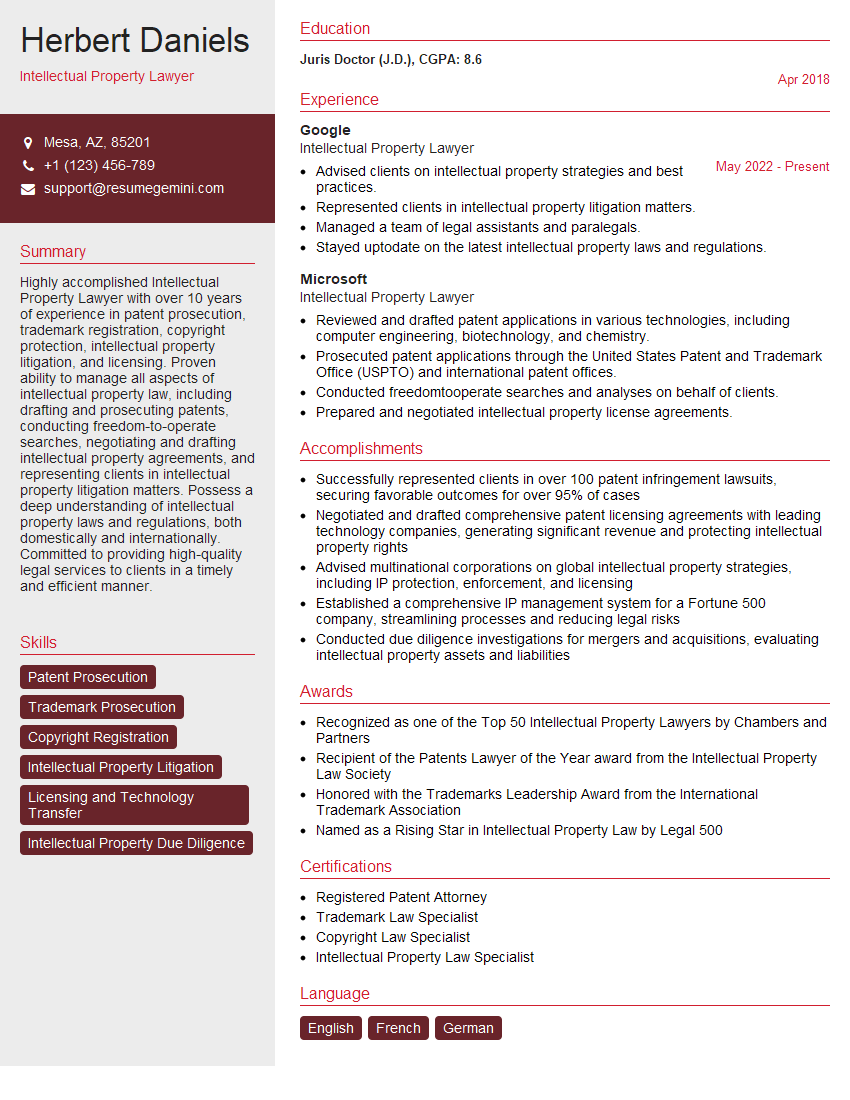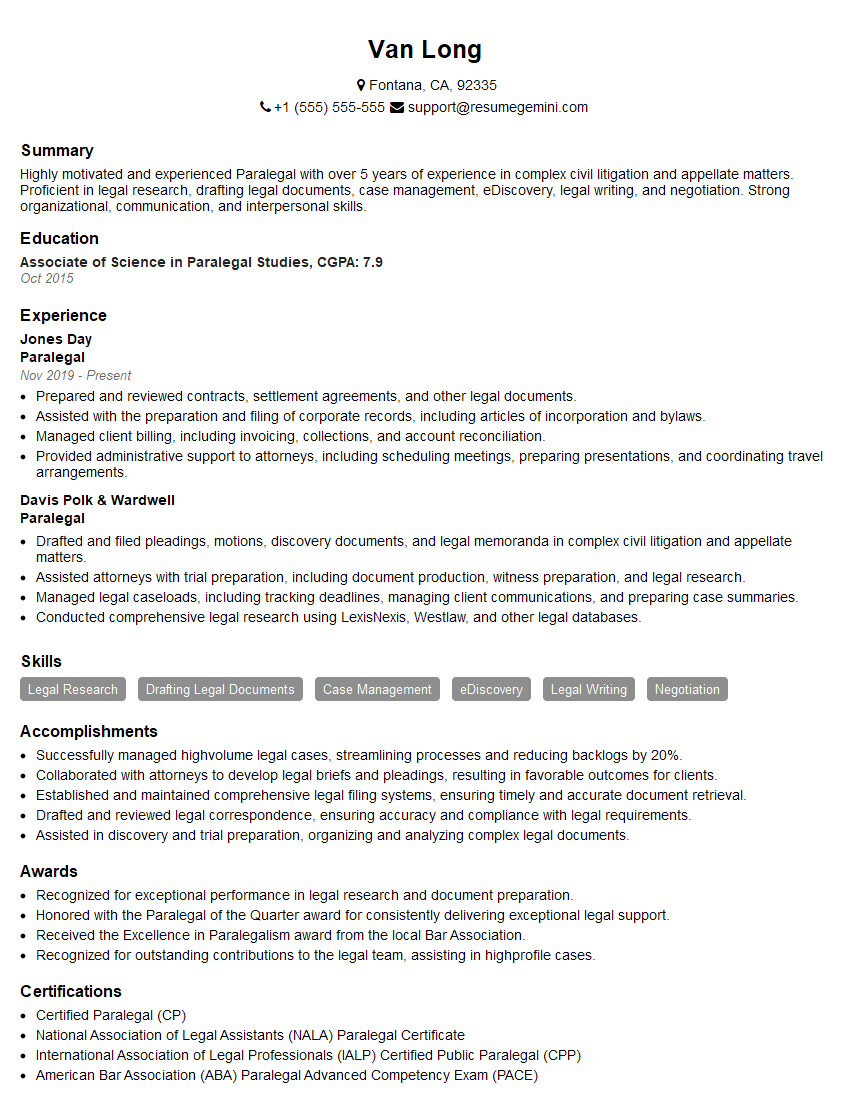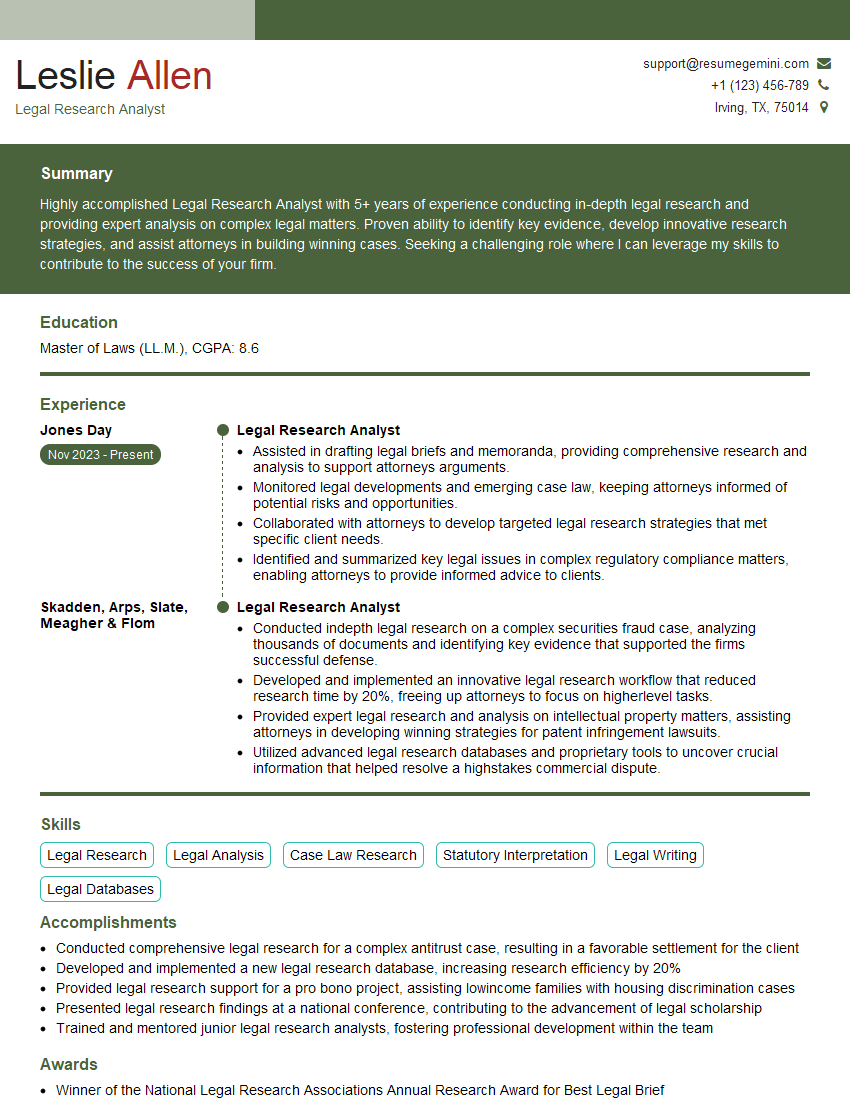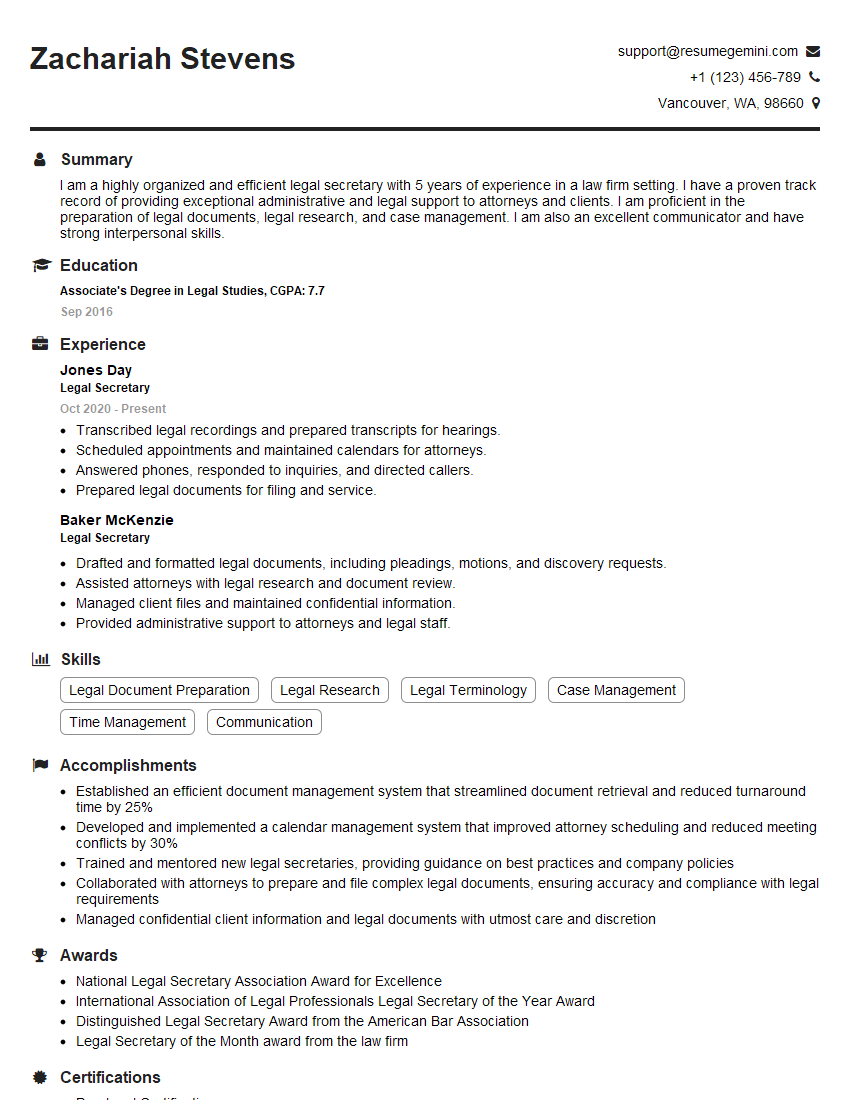The right preparation can turn an interview into an opportunity to showcase your expertise. This guide to Knowledge of Legal Requirements interview questions is your ultimate resource, providing key insights and tips to help you ace your responses and stand out as a top candidate.
Questions Asked in Knowledge of Legal Requirements Interview
Q 1. Explain the difference between civil and criminal law.
Civil and criminal law are distinct branches of the legal system, addressing different types of wrongs and pursuing different objectives. Think of it like this: civil law deals with disputes between individuals or entities, while criminal law deals with offenses against the state.
- Civil Law: Focuses on resolving disputes between private parties, aiming for compensation or remedies. Examples include breach of contract, negligence (leading to personal injury lawsuits), property disputes, and family law matters (divorce, child custody). The burden of proof is typically a preponderance of the evidence (more likely than not).
- Criminal Law: Concerned with actions that violate established laws and threaten public safety. Examples include murder, theft, assault, and fraud. The government prosecutes these cases, aiming for punishment (jail time, fines) to deter future crimes. The burden of proof is much higher, requiring proof beyond a reasonable doubt.
A key difference lies in the consequences. In civil cases, the outcome usually involves financial compensation or equitable remedies. In criminal cases, the consequences can be imprisonment, fines, or other penalties imposed by the state.
Q 2. Describe your experience with contract review and negotiation.
I have extensive experience in contract review and negotiation, spanning various industries. My approach involves a meticulous review of each clause to identify potential risks and opportunities. This includes analyzing the language for clarity, ensuring alignment with client goals, and anticipating potential disputes.
For example, in a recent negotiation for a software licensing agreement, I identified a clause that could expose my client to significant liability in case of a software failure. Through negotiation, I successfully revised the clause to limit the client’s liability to a reasonable amount, significantly reducing the risk. In another instance, I helped a client secure more favorable payment terms and intellectual property rights.
My process includes:
- Initial Assessment: Understanding the business objectives and risk tolerance of the client.
- Detailed Review: Analyzing every clause, including definitions, payment terms, liability clauses, intellectual property rights, and dispute resolution mechanisms.
- Negotiation Strategy: Identifying areas for improvement and developing a negotiation strategy based on the client’s goals and risk profile.
- Risk Mitigation: Identifying potential risks and developing strategies to mitigate them.
- Final Review: Ensuring the final contract accurately reflects the agreed-upon terms.
Q 3. How familiar are you with HIPAA regulations?
I am very familiar with HIPAA (Health Insurance Portability and Accountability Act) regulations. HIPAA is a US federal law designed to protect the privacy and security of Protected Health Information (PHI).
My understanding encompasses the key provisions, including:
- Privacy Rule: Governs the use and disclosure of PHI. This includes requirements for obtaining patient consent, maintaining confidentiality, and implementing safeguards to protect PHI.
- Security Rule: Establishes security standards for electronic PHI (ePHI), covering administrative, physical, and technical safeguards.
- Breach Notification Rule: Requires covered entities to notify individuals and government agencies in the event of a data breach.
I have assisted clients in developing HIPAA compliance programs, conducting risk assessments, and responding to data breaches. Understanding HIPAA is crucial for any organization handling sensitive health information, as non-compliance can result in significant fines and reputational damage.
Q 4. What is your understanding of GDPR and its implications?
The GDPR (General Data Protection Regulation) is a comprehensive data privacy regulation in the European Union and the European Economic Area. It aims to give individuals more control over their personal data. Its implications are far-reaching, impacting organizations worldwide that process the personal data of EU residents.
My understanding of GDPR includes its core principles:
- Lawfulness, Fairness, and Transparency: Data processing must have a legal basis, be fair, and be transparent to the data subject.
- Purpose Limitation: Data should be collected for specified, explicit, and legitimate purposes.
- Data Minimization: Only necessary data should be collected.
- Accuracy: Data should be accurate and kept up to date.
- Storage Limitation: Data should only be kept for as long as necessary.
- Integrity and Confidentiality: Data should be processed securely.
Non-compliance with GDPR can lead to substantial fines. My experience includes advising clients on GDPR compliance, developing data protection policies, and conducting data protection impact assessments (DPIAs).
Q 5. Explain your process for identifying and mitigating legal risks.
My process for identifying and mitigating legal risks is proactive and systematic. It involves a risk-based approach, starting with a thorough understanding of the client’s operations and the legal landscape relevant to their industry.
My process typically includes:
- Risk Identification: Identifying potential legal risks through a combination of methods such as reviewing contracts, policies, and procedures; conducting legal research; and interviewing key personnel.
- Risk Assessment: Evaluating the likelihood and potential impact of each identified risk.
- Risk Mitigation: Developing strategies to reduce the likelihood or impact of each risk. This could involve revising contracts, implementing new policies, providing training, or purchasing insurance.
- Monitoring and Review: Regularly monitoring the effectiveness of implemented mitigation strategies and updating the risk assessment as necessary.
For example, in advising a startup, I identified a significant risk related to intellectual property protection. We mitigated this by developing a comprehensive IP strategy, including trademark registration and patent applications.
Q 6. How would you handle a situation where a legal requirement is unclear or conflicting?
When a legal requirement is unclear or conflicting, my approach is methodical and prioritizes minimizing risk. It’s crucial to avoid making assumptions.
My steps would be:
- Thorough Research: Conduct comprehensive legal research using reliable sources such as primary legislation, case law, and authoritative legal commentaries. If applicable, consult legal databases and engage experts in the relevant field.
- Seek Clarification: If uncertainty persists, seek clarification from the relevant regulatory authority or legal counsel specializing in the area. This might involve submitting written inquiries or attending consultations.
- Develop a Strategy Based on Risk Assessment: Assess the potential risks associated with each interpretation of the unclear or conflicting requirement. Choose the approach that best mitigates the potential downsides, while documenting the rationale for the decision.
- Documentation: Meticulously document the entire process, including the research conducted, the ambiguities identified, the rationale for the chosen course of action, and any communication with regulatory bodies or legal counsel. This documentation protects against future liability.
It’s always better to err on the side of caution and prioritize compliance, even if it means implementing more conservative interpretations in the face of ambiguity.
Q 7. Describe your experience with legal research and analysis.
Legal research and analysis are fundamental to my practice. My experience includes using various research methodologies, including:
- Primary Sources: Working directly with statutes, regulations, case law, and constitutions to understand the law’s precise meaning.
- Secondary Sources: Utilizing legal treatises, law review articles, and legal journals to analyze and interpret the law.
- Legal Databases: Employing tools like Westlaw and LexisNexis to conduct efficient and comprehensive searches.
My analytical skills involve not just finding relevant legal materials but also critically evaluating their relevance, interpreting their meaning in context, and synthesizing the information to provide clear and concise advice. For example, in a recent case involving data privacy, I reviewed hundreds of pages of legal materials to develop a comprehensive legal strategy that successfully protected my client’s interests.
Q 8. How proficient are you in interpreting legal documents and legislation?
Interpreting legal documents and legislation requires a keen eye for detail and a systematic approach. It’s not just about reading the words; it’s about understanding the context, the intent, and the potential implications. My proficiency stems from years of experience analyzing statutes, contracts, regulations, and case law. I utilize a multi-step process: first, I carefully read the document to gain a general understanding. Then, I meticulously examine each clause, definition, and exception, noting any ambiguities or contradictions. Next, I research relevant case law and secondary sources to gain a deeper understanding of the legal principles involved. Finally, I synthesize all this information to arrive at a clear and accurate interpretation. For example, I recently interpreted a complex contract clause regarding intellectual property ownership, requiring me to cross-reference several sections and consider relevant precedent cases to determine the exact rights and responsibilities of each party involved.
Q 9. What is your experience with compliance audits and reporting?
Compliance audits and reporting are crucial for ensuring an organization adheres to all applicable laws and regulations. My experience encompasses conducting internal audits, reviewing external audit reports, and preparing compliance reports for various regulatory bodies. This involves identifying potential risks, evaluating existing controls, and recommending improvements. I’m familiar with various audit methodologies, including risk-based auditing and internal control frameworks like COSO. For instance, during a recent audit of a healthcare provider, I identified a weakness in their HIPAA compliance procedures concerning patient data security, which I addressed by recommending specific policy and process changes. I also have experience preparing reports for regulatory bodies, ensuring accuracy and compliance with reporting requirements.
Q 10. Describe a time you had to explain complex legal concepts to a non-legal audience.
Explaining complex legal concepts to a non-legal audience necessitates clear, concise communication and the ability to use relatable analogies. I once had to explain the nuances of data breach notification laws to a group of marketing executives. Instead of using legal jargon, I used a simple analogy: imagine a bank’s responsibility to notify customers if their accounts are compromised. Similarly, companies have a legal obligation to notify individuals if their personal data is breached. I then broke down the legal requirements into manageable chunks, focusing on their practical implications for the marketing campaigns. By using real-world examples and avoiding technical terms, I successfully ensured that the executives understood the legal ramifications and how to mitigate risks.
Q 11. How familiar are you with Sarbanes-Oxley Act (SOX)?
The Sarbanes-Oxley Act (SOX) of 2002 is a landmark legislation designed to protect investors by improving the accuracy and reliability of corporate disclosures. My understanding of SOX encompasses its key provisions, including those related to corporate responsibility, financial disclosures, internal controls, and auditor independence. I understand the implications of Section 302, which mandates that company executives certify the accuracy of financial reports, and Section 404, which requires management to document and test the effectiveness of internal controls over financial reporting. I’m proficient in identifying SOX compliance gaps and helping companies implement measures to address them. I have experience assisting companies in developing and implementing SOX-compliant internal controls and preparing the necessary documentation for audits.
Q 12. What is your understanding of intellectual property rights?
Intellectual property (IP) rights encompass the legal rights granted to creators and inventors for their original works. This includes patents (for inventions), trademarks (for brands), copyrights (for creative works like books and software), and trade secrets (for confidential information). My understanding includes the different types of IP rights, the processes for obtaining protection, and the legal implications of IP infringement. For example, I advised a client on securing trademark protection for their new brand, guiding them through the application process and ensuring they avoided any potential conflicts with existing trademarks. I also have experience in drafting and reviewing IP licensing agreements, ensuring that the rights and obligations of each party are clearly defined.
Q 13. How would you ensure compliance with data privacy regulations?
Ensuring compliance with data privacy regulations requires a multifaceted approach. This includes understanding the applicable laws, such as GDPR, CCPA, and HIPAA, depending on the geographic location and the type of data being processed. The key steps include conducting a data privacy impact assessment (DPIA) to identify potential risks, implementing appropriate technical and organizational measures to protect personal data, establishing data retention policies, and providing individuals with control over their data. This also involves developing robust procedures for handling data breaches, including timely notification to affected individuals and regulatory authorities. For example, I assisted a company in implementing a GDPR-compliant data processing system, which involved implementing appropriate consent mechanisms, data minimization practices, and data security measures.
Q 14. Explain your understanding of the legal implications of social media usage in the workplace.
The legal implications of social media usage in the workplace are significant. Companies need to establish clear social media policies to protect their reputation, maintain employee productivity, and comply with applicable laws. These policies should address issues like confidentiality, data privacy, harassment, and defamation. Employees’ social media activities can have legal consequences for both the employee and the employer. For instance, an employee posting confidential company information on social media could be a breach of contract or even a criminal offense. Similarly, an employee making defamatory statements about a colleague or the company could expose the employer to legal liability. Therefore, a well-defined social media policy is crucial for managing risks and preventing legal problems. Such a policy should clarify acceptable use, employee conduct, and the employer’s right to monitor employee activity on company-owned devices or during work hours.
Q 15. Describe your experience with handling legal disputes.
Throughout my career, I’ve been involved in numerous legal disputes, ranging from contract breaches to intellectual property infringements. My approach is always methodical and strategic, focusing first on understanding the core issue and the client’s objectives. This involves a thorough review of all relevant documentation, communication with opposing parties (when appropriate), and careful consideration of potential legal precedents.
For instance, I once represented a technology startup in a breach of contract dispute. The client’s agreement with a major corporation contained ambiguous clauses. My team carefully analyzed the contract language, relevant case law, and industry standards to build a strong defense. We ultimately negotiated a favorable settlement that avoided costly litigation.
Another example involved a dispute over patent infringement. Here, a deep dive into the patent claims, prior art, and the accused product was critical. This meticulous analysis enabled us to identify weaknesses in the opponent’s case and ultimately secure a dismissal.
- Thorough investigation: Gathering all relevant facts and evidence.
- Legal research: Identifying applicable laws and precedents.
- Negotiation: Seeking amicable resolutions whenever possible.
- Litigation: Preparing and presenting a strong case in court if necessary.
Career Expert Tips:
- Ace those interviews! Prepare effectively by reviewing the Top 50 Most Common Interview Questions on ResumeGemini.
- Navigate your job search with confidence! Explore a wide range of Career Tips on ResumeGemini. Learn about common challenges and recommendations to overcome them.
- Craft the perfect resume! Master the Art of Resume Writing with ResumeGemini’s guide. Showcase your unique qualifications and achievements effectively.
- Don’t miss out on holiday savings! Build your dream resume with ResumeGemini’s ATS optimized templates.
Q 16. How do you stay updated on changes in relevant legal requirements?
Staying abreast of legal changes is paramount in my field. I utilize a multi-pronged approach to ensure my knowledge remains current. This includes:
- Subscription to legal databases and journals: I regularly access resources like LexisNexis and Westlaw for updates on legislation, case law, and regulatory changes.
- Participation in professional development activities: Attending conferences, webinars, and workshops provides invaluable insights and networking opportunities.
- Monitoring relevant government agencies: I closely follow announcements and publications from agencies like the SEC, FTC, and relevant state bar associations.
- Networking with legal professionals: Engaging with colleagues and experts through professional organizations keeps me informed of emerging trends and challenges.
For example, when the CCPA (California Consumer Privacy Act) was enacted, I immediately dedicated time to understanding its implications and ensuring compliance for our clients. This involved internal training and updating relevant policies and procedures.
Q 17. What is your understanding of corporate governance and compliance?
Corporate governance and compliance are intrinsically linked. Corporate governance refers to the system of rules, practices, and processes by which a company is directed and controlled. Compliance, on the other hand, ensures adherence to all relevant laws, regulations, and internal policies. Effective corporate governance is essential for promoting ethical conduct, mitigating risk, and building stakeholder trust; compliance is the mechanism for achieving this.
Think of it like a car: corporate governance is the steering wheel and the roadmap, guiding the company’s direction; compliance is the engine, ensuring the car runs smoothly and follows the rules of the road. Without a strong governance framework, compliance efforts will be fragmented and ineffective.
My understanding encompasses various aspects, including:
- Board structure and composition: The roles and responsibilities of board members.
- Risk management: Identifying and mitigating potential legal and financial risks.
- Financial reporting and disclosure: Accuracy and transparency in financial statements.
- Ethical conduct: Implementing and enforcing codes of ethics and conduct.
Q 18. Describe your experience with developing and implementing compliance programs.
I have extensive experience in developing and implementing comprehensive compliance programs. This usually involves a multi-stage process:
- Needs assessment: Identifying specific legal and regulatory requirements applicable to the organization.
- Risk assessment: Evaluating the potential for non-compliance and prioritizing risks.
- Policy development: Creating clear, concise, and accessible policies and procedures that align with legal requirements.
- Training and education: Providing comprehensive training to employees at all levels on relevant policies and procedures.
- Monitoring and auditing: Regularly assessing compliance through internal audits and self-assessments.
- Remediation: Implementing corrective actions to address any identified non-compliance issues.
For example, I helped a healthcare provider implement a HIPAA compliance program. This involved developing new policies, training staff on HIPAA regulations, conducting regular audits, and implementing robust data security measures. The result was a significant reduction in compliance risk and improved patient data protection.
Q 19. How would you handle a breach of legal requirements?
Handling a breach of legal requirements requires a swift and decisive response. The first step is to contain the damage and prevent further violations. This involves:
- Immediate investigation: Determining the scope and nature of the breach.
- Notification: Reporting the breach to relevant authorities (if required) and affected parties.
- Remediation: Implementing corrective actions to address the root cause of the breach and prevent recurrence.
- Documentation: Maintaining meticulous records of all actions taken.
- Cooperation: Cooperating fully with any investigations conducted by regulatory agencies.
For instance, if a company discovers a data breach, it must immediately investigate to determine the extent of the breach, notify affected individuals, and take steps to improve data security. Failure to do so could result in significant fines and reputational damage.
Q 20. What are some common legal challenges faced by businesses in your industry?
The legal challenges faced by businesses vary widely depending on the industry. However, some common challenges include:
- Data privacy and security: Compliance with regulations like GDPR and CCPA is crucial for businesses that collect and process personal data.
- Intellectual property protection: Protecting trade secrets, patents, copyrights, and trademarks is vital for many businesses.
- Employment law: Navigating complex employment regulations, including wage and hour laws, discrimination laws, and workplace safety regulations.
- Contract law: Drafting and negotiating clear, enforceable contracts is essential for all business transactions.
- Antitrust laws: Avoiding anti-competitive practices is important to avoid legal challenges.
For example, in the technology industry, intellectual property rights are paramount, often leading to disputes over patent infringement or software licensing.
Q 21. Explain your understanding of antitrust laws.
Antitrust laws are designed to promote competition and prevent monopolies. They prohibit anti-competitive practices that stifle innovation and harm consumers. These laws are aimed at ensuring a fair and competitive marketplace.
Key aspects of antitrust law include:
- Monopolization: The illegal acquisition or maintenance of monopoly power through anti-competitive conduct.
- Price fixing: Agreements between competitors to set prices at an artificially high level.
- Market allocation: Agreements among competitors to divide markets and prevent competition.
- Mergers and acquisitions: The government may block mergers and acquisitions that would significantly reduce competition.
A classic example of an antitrust violation would be two competing companies agreeing to set prices for a particular product above market rates. This would harm consumers and violate antitrust laws.
Q 22. How would you ensure compliance with environmental regulations?
Ensuring compliance with environmental regulations requires a proactive and multi-faceted approach. It’s not simply about reacting to violations; it’s about integrating environmental consciousness into every aspect of business operations.
Environmental Impact Assessment (EIA): Before undertaking any project, a thorough EIA is crucial to identify potential environmental impacts. This involves analyzing factors like air and water pollution, waste generation, and habitat disruption. For example, a construction company would conduct an EIA to assess the impact of a new building project on local wetlands.
Permitting and Licensing: Securing all necessary permits and licenses from relevant environmental agencies is paramount. This process often involves submitting detailed applications demonstrating compliance with specific regulations. Failure to obtain the correct permits can lead to hefty fines and project delays. Think of a manufacturing plant needing discharge permits for wastewater.
Ongoing Monitoring and Reporting: Regular monitoring of environmental performance is essential. This involves tracking emissions, waste disposal, and resource consumption. Data must be meticulously recorded and reported to regulatory authorities according to established timelines. Imagine a power plant regularly monitoring its CO2 emissions and submitting reports to the EPA.
Employee Training: Educating employees about environmental regulations and best practices is crucial. This includes training on waste management, chemical handling, and emergency response procedures. A well-trained workforce is more likely to prevent accidents and ensure compliance.
Regular Audits and Reviews: Conducting internal and external audits ensures continuous improvement and identifies areas for improvement. Regular reviews of environmental management systems help maintain compliance and prevent potential violations.
A robust environmental compliance program is not just a legal necessity; it’s a demonstration of corporate social responsibility and a way to build a sustainable and profitable business.
Q 23. Describe your experience with legal technology and tools.
My experience with legal technology and tools is extensive. I’m proficient in using various legal research databases like Westlaw and LexisNexis, and I regularly leverage e-discovery platforms for managing and reviewing large volumes of data in litigation. I’m also familiar with contract management software that automates contract review and ensures compliance with company policies.
Beyond these tools, I’ve successfully implemented and managed legal tech solutions for case management, document automation, and legal hold processes. This has significantly improved efficiency and accuracy in managing legal tasks, reducing manual effort and streamlining workflows. For instance, I utilized a specific case management system to track the progress of hundreds of cases, providing real-time insights into deadlines, key dates and overall case status. This improved our team’s response times and reduced errors.
I am always eager to explore and adopt new technologies that can improve legal practice and efficiency. I believe technology is a powerful tool for enhancing legal risk management and providing better client service.
Q 24. How would you conduct a legal risk assessment?
Conducting a legal risk assessment involves a systematic evaluation of potential legal problems that could affect an organization. It’s a proactive approach to identify and mitigate risks before they escalate into significant issues.
Identify Potential Risks: This step involves brainstorming potential legal risks relevant to the organization’s activities. Examples include contract disputes, intellectual property infringement, employment litigation, environmental violations, or regulatory non-compliance. We consider both internal and external factors.
Analyze the Likelihood and Impact: For each identified risk, we assess the likelihood of it occurring and the potential impact if it does. This often involves assigning numerical scores or using qualitative descriptions (e.g., low, medium, high).
Evaluate Existing Controls: We review current practices and controls designed to mitigate the identified risks. This could include insurance policies, contracts, compliance programs, or internal policies. We assess their effectiveness.
Develop Mitigation Strategies: Based on the risk assessment, we develop strategies to mitigate identified risks. This could involve implementing new controls, modifying existing procedures, or transferring the risk through insurance. For example, for a contract dispute risk, the mitigation strategy might involve stricter contract review processes and better communication clauses.
Monitor and Review: The risk assessment is not a one-time event. It’s an ongoing process that should be regularly reviewed and updated to reflect changes in the organization’s activities, the legal landscape, and the effectiveness of implemented mitigation strategies.
A well-structured legal risk assessment provides a clear understanding of the organization’s vulnerabilities and helps prioritize resources to address the most significant threats.
Q 25. What is your experience with internal investigations?
I have extensive experience conducting internal investigations, encompassing a wide range of issues, including allegations of financial misconduct, ethical violations, discrimination, harassment, and regulatory non-compliance. My approach is always thorough, objective, and confidential.
The process typically involves:
Securing and Preserving Evidence: This is a crucial initial step, requiring the immediate preservation of relevant documents, electronic data, and witness testimony to avoid spoliation (the intentional or negligent destruction of evidence).
Interviewing Witnesses: I conduct interviews with all relevant individuals, utilizing established interviewing techniques to obtain accurate and reliable information. Maintaining confidentiality and professionalism is paramount.
Document Review: This involves reviewing emails, contracts, financial records, and other relevant documents to establish the facts of the matter.
Report Writing: Once the investigation is complete, I prepare a comprehensive report summarizing the findings, conclusions, and recommendations for remedial action.
In one particular instance, I led an investigation into allegations of insider trading within a publicly traded company. The meticulous collection and analysis of trading data, coupled with witness interviews, allowed us to determine whether the alleged violations had occurred, ultimately leading to appropriate disciplinary action. This process required strong knowledge of securities regulations, the ability to analyze complex financial data, and an approach that maintained confidentiality throughout.
Q 26. How would you advise a company on mitigating legal risks associated with a new product launch?
Advising a company on mitigating legal risks associated with a new product launch requires a comprehensive approach that addresses potential issues before they become significant problems. It’s about building a strong legal foundation from the outset.
Intellectual Property Protection: Ensure all aspects of the product, including its design, functionality, and branding, are adequately protected through patents, trademarks, and copyrights. This involves conducting thorough prior art searches to avoid infringement issues.
Product Safety and Liability: Conduct rigorous testing to ensure the product meets all relevant safety standards and regulations. Develop clear warning labels and instructions for use. Explore product liability insurance options to mitigate potential legal exposure.
Compliance with Regulations: Determine all applicable regulations, including industry-specific standards, labeling requirements, and safety certifications. This might include FDA regulations for food and drugs, or FCC regulations for electronic devices.
Privacy and Data Security: If the product collects or processes personal data, ensure compliance with data protection laws like GDPR or CCPA. Implement robust data security measures to prevent data breaches.
Advertising and Marketing: Ensure all advertising and marketing materials accurately reflect the product’s capabilities and avoid misleading or deceptive claims. This is particularly important considering consumer protection laws.
Contractual Agreements: Carefully review and negotiate all contracts related to the product launch, including manufacturing agreements, distribution agreements, and licensing agreements.
By proactively addressing these legal risks, companies can significantly reduce their exposure to costly litigation, reputational damage, and regulatory penalties, ensuring a successful product launch.
Q 27. Explain your understanding of employment law and its impact on HR practices.
Employment law significantly impacts HR practices by establishing the legal framework for the employer-employee relationship. Compliance is crucial to avoid costly lawsuits and reputational damage.
Key areas of employment law impacting HR include:
Hiring and Recruitment: Laws prohibit discrimination based on protected characteristics (race, religion, gender, age, disability, etc.). HR must ensure fair and unbiased hiring practices.
Compensation and Benefits: Regulations govern minimum wage, overtime pay, and employee benefits (health insurance, retirement plans). HR must ensure compliance with wage and hour laws.
Workplace Safety: Employers have a legal duty to provide a safe working environment. HR plays a key role in implementing and enforcing safety regulations and procedures.
Employee Discipline and Termination: Laws govern the grounds for employee dismissal and the process for termination. HR must ensure that all terminations are conducted legally and fairly.
Leave and Absences: Regulations govern various types of leave, including sick leave, family leave, and military leave. HR manages these leave requests while ensuring compliance.
Employee Privacy: Laws protect employee privacy, requiring employers to handle employee data responsibly. HR must ensure compliance with these privacy laws.
Effective HR practices integrate a strong understanding of employment law. This ensures a compliant workplace, fosters a positive employee relationship, and protects the organization from legal challenges. Ignoring employment law can lead to significant fines, reputational harm, and employee morale issues.
Q 28. How would you navigate ethical dilemmas related to legal requirements?
Navigating ethical dilemmas related to legal requirements often requires balancing competing interests and values. It’s about making principled decisions even when faced with difficult choices.
My approach involves:
Identifying the Ethical Dilemma: Clearly articulate the ethical conflict. For example, is there a conflict between client confidentiality and public safety?
Gathering Information: Collect all relevant facts and information to thoroughly understand the situation.
Considering Relevant Ethical Frameworks: Apply relevant ethical principles, such as utilitarianism (maximizing overall good), deontology (adherence to moral duties), and virtue ethics (focus on character and integrity).
Seeking Advice and Consultation: Consult with colleagues, supervisors, or ethics committees for guidance and diverse perspectives. Legal counsel may also be necessary.
Documenting Decision-Making: Maintain detailed records of the decision-making process, including the ethical considerations involved and the rationale for the chosen course of action.
Implementing and Evaluating the Decision: Carry out the chosen course of action and assess its effectiveness and ethical implications. Be prepared to adjust the course of action if necessary.
Ethical dilemmas in legal practice are inevitable. A robust ethical framework coupled with a commitment to transparency and integrity allows one to make informed decisions that uphold both the law and professional ethics.
Key Topics to Learn for Knowledge of Legal Requirements Interview
- Data Privacy Regulations: Understanding GDPR, CCPA, and other relevant regulations; applying these principles in practical scenarios such as data handling and security protocols.
- Contract Law Fundamentals: Interpreting contract clauses, identifying potential risks and liabilities, and understanding the implications of breach of contract; practical application in reviewing and drafting agreements.
- Intellectual Property Rights: Knowledge of copyright, trademarks, and patents; analyzing scenarios involving IP infringement and strategies for protection.
- Compliance and Risk Management: Implementing compliance programs, conducting risk assessments, and developing mitigation strategies; analyzing case studies of legal violations and their consequences.
- Regulatory Compliance Frameworks: Understanding industry-specific regulations and their impact on business operations; applying knowledge to real-world compliance challenges.
- Legal Research and Analysis: Effectively utilizing legal databases and resources to conduct thorough research and analyze legal precedents; applying research findings to practical legal problems.
Next Steps
Mastering Knowledge of Legal Requirements is crucial for career advancement in today’s complex regulatory landscape. A strong understanding of these concepts demonstrates your professionalism and reduces potential legal risks for your employer. To significantly boost your job prospects, create an ATS-friendly resume that highlights your relevant skills and experience. ResumeGemini is a trusted resource that can help you build a compelling and effective resume tailored to the specific requirements of legal roles. We provide examples of resumes tailored to Knowledge of Legal Requirements to guide you in showcasing your expertise effectively. Take the next step towards your dream job – build a standout resume with ResumeGemini today!
Explore more articles
Users Rating of Our Blogs
Share Your Experience
We value your feedback! Please rate our content and share your thoughts (optional).
What Readers Say About Our Blog
Hi, I’m Jay, we have a few potential clients that are interested in your services, thought you might be a good fit. I’d love to talk about the details, when do you have time to talk?
Best,
Jay
Founder | CEO
